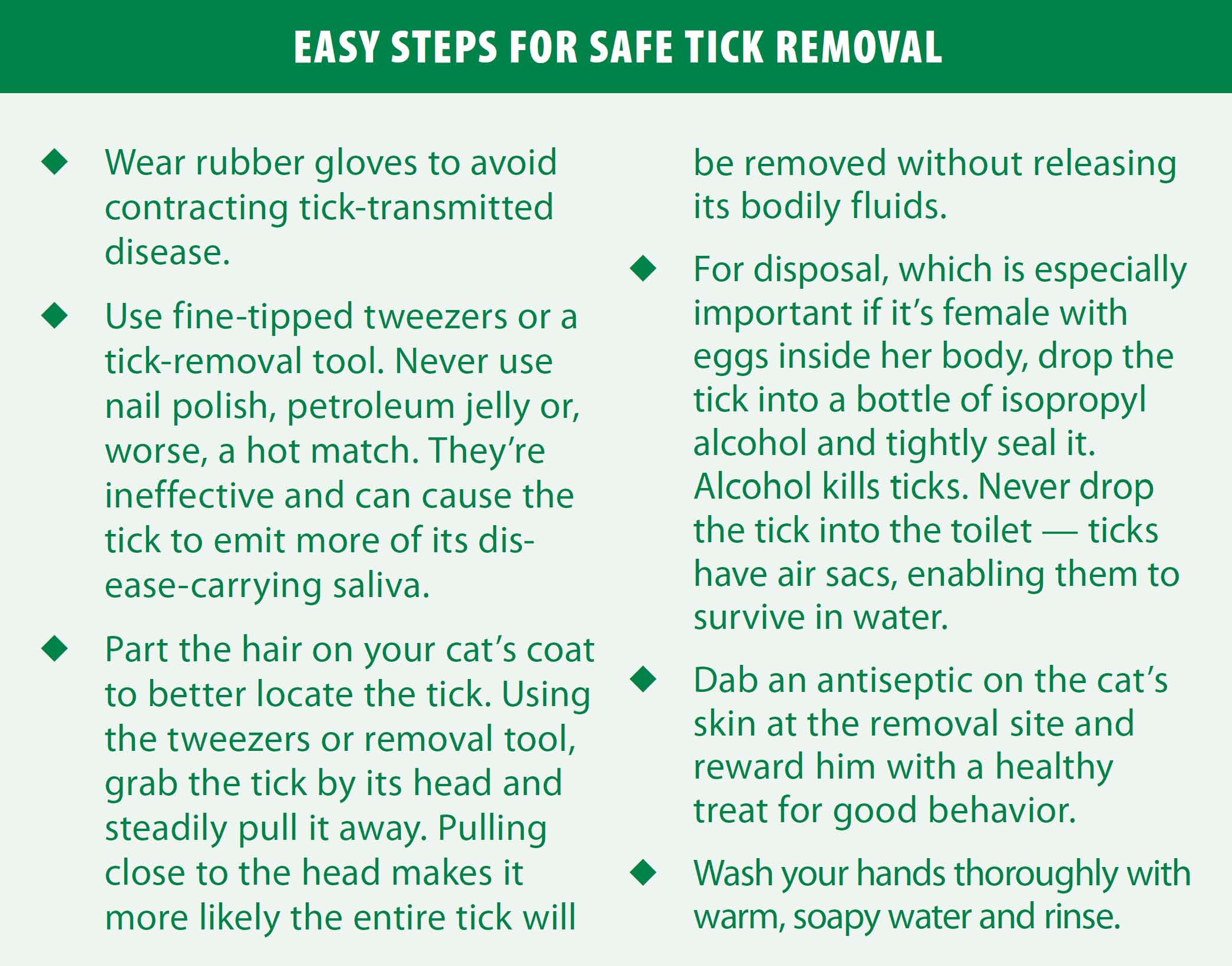Ticks pose a year-round threat to cats in every state — even if yours spends virtually all his time indoors. These minute arachnids have survived for millennia and often go undetected as they feed on their host’s blood, often causing serious illness and even death.
“The major problem with ticks is that they are vectors for various infectious agents,” says dermatologist William H. Miller, VMD, at the Cornell University College of Veterinary Medicine. “Ticks are unable to fly or jump. They climb to the top of blades of grass and weeds and wait for a host to pass when they move from the plant to the host — which could be your cat. Or they hop a ride on your clothes and you unintentionally bring them inside your home.”
The Start of Signs. As soon as the tick attaches itself to your cat, bacteria start to reproduce in the area surrounding the bite. Pathogens pour into the bloodstream and symptoms, which can be as severe as paralysis, begin to develop.
The best weapons to combat ticks are new medications to prevent and kill ticks, and the education of owners so that they can take the proper steps to protect pets, says Dwight Bowman, Ph.D., MS, professor of parasitology at Cornell.
“We are getting more ticks for three main reasons,” says Dr. Bowman, immediate past president of the Companion Animal Parasite Council, an independent group that creates guidelines for the control of parasites threatening pets and people.
“First, we are much friendlier to wildlife. There are huge deer and turkey populations that help feed ticks. Second, we are doing away with manicured lawns and opting for lush backyards with streams or water fountains, trees, bushes and bird feeders that attract deer and squirrels. Third, we are more opposed to using pesticides in our backyards, which only puts out the welcome mat for ticks and rodents to come closer to our homes.”
According to the Centers for Disease Control and Prevention, these three serious tick-borne diseases affect cats:
– Babesiosis: Caused by a protozoa, this disease infects red blood cells and triggers fever, anemia and weight loss. The deer tick is the primary transmitter of this disease that also can affect dogs and people.
– Cytauxzoonosis: This potentially lethal infection is caused by a blood parasite. The natural reservoir host for this disease is the bobcat. It can be transmitted to your cat by bites from the lone star tick or American dog tick. Symptoms can include the sudden onset of a high fever, pale gums, respiratory distress and jaundice.
– Tularemia: Informally known as “rabbit fever,” this disease is caused by the bacterium Francisella tularensis. As its name implies, it’s found in rabbits and rodents, and transmitted to cats — and people — through bites by the American dog tick. Symptoms can include fever, nasal discharge, loss of appetite and listlessness.
While dogs and people are at risk for Lyme disease from infected ticks, cats are highly resistant to the bacteria that cause it and rarely show signs of it, Dr. Miller says. “Currently, there isn’t any one product that will be 100 percent effective for all dogs and cats. The number of products for cats is limited because they tend to be sensitive to commonly used ingredients.”
For the past decade, topical monthly preventive medications applied between cats’ shoulder blades have been the popular choice among owners, and several good ones are on the market. Flea and tick preventives for dogs may contain permethrin and should not be used on cats because of its toxicity. Recently an anti-flea-and-tick collar has been released for cats. Looking ahead, Dr. Miller sees merit in a new generation of tick preventives being developed in pill form.
For now, Dr. Bowman recommends preventing your backyard from becoming a haven for ticks by keeping your grass trimmed, clearing bushes and shrubs along the exterior walls of your home and discouraging wildlife, especially deer and squirrels. “If a pesticide is to be used, make sure the product is specifically licensed for yard use, used according to label directions and will not harm your pet,” he adds.
Your best defense against ticks causing disease in your cat: “I believe that pets need to be on year-round flea and tick control from birth to death,” says Dr. Bowman. “Always make sure your cat receives a thorough physical examination by a veterinarian at least once a year, ideally twice a year. That visit should include health screen diagnostic tests.”

425

400



